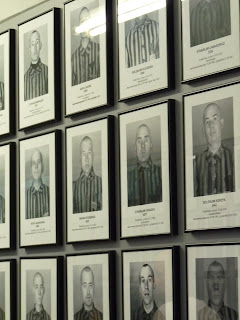Once inside the imposing brick buildings that seem so innocent from the outside there are several devastatingly simple displays.
One room is completely empty except for a glazed section that runs from one end to the other. Behind the glass, from floor to ceiling, is an immense mountain of human hair.
Another room houses piles upon piles of suitcases, taken from the prisoners. Many are marked with the star of David, others poignantly say "mit kinder".
Mounds of spectacles gaze blankly out at you from another while endless shoes are a silent testimony to the thousands of people who, once incarcerated, never walked out of the death camps.
Another of the buildings contains a corridor lined with endless black and white photographs of prisoners. All in the regulation striped uniform, all with roughly shaven heads.
The women seem particularly to have been callously treated, their hair, once a crowning glory now stripped to degrade and humiliate them.
It is a gallery of despair, where every pair of eyes is a mute plea for mercy that never came.
The horror of Auschwitz is not immediately tangible when you walk through the gates, it was not the instant cloying weight that I thought it would be. It gradually builds, with each room, each exhibit, each photograph.
By the time you end up in the gas chamber, the ultimate symbol of evil, it feels difficult to breathe, your eyes have taken in too much but not comprehended. It is only later that you cry.







No comments:
Post a Comment